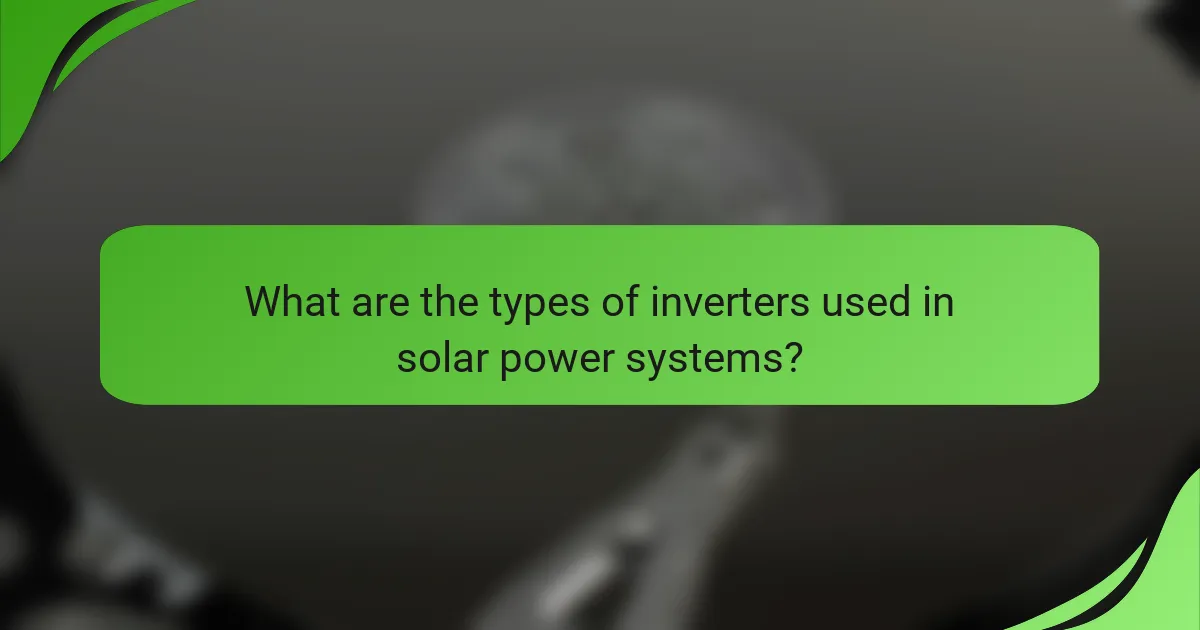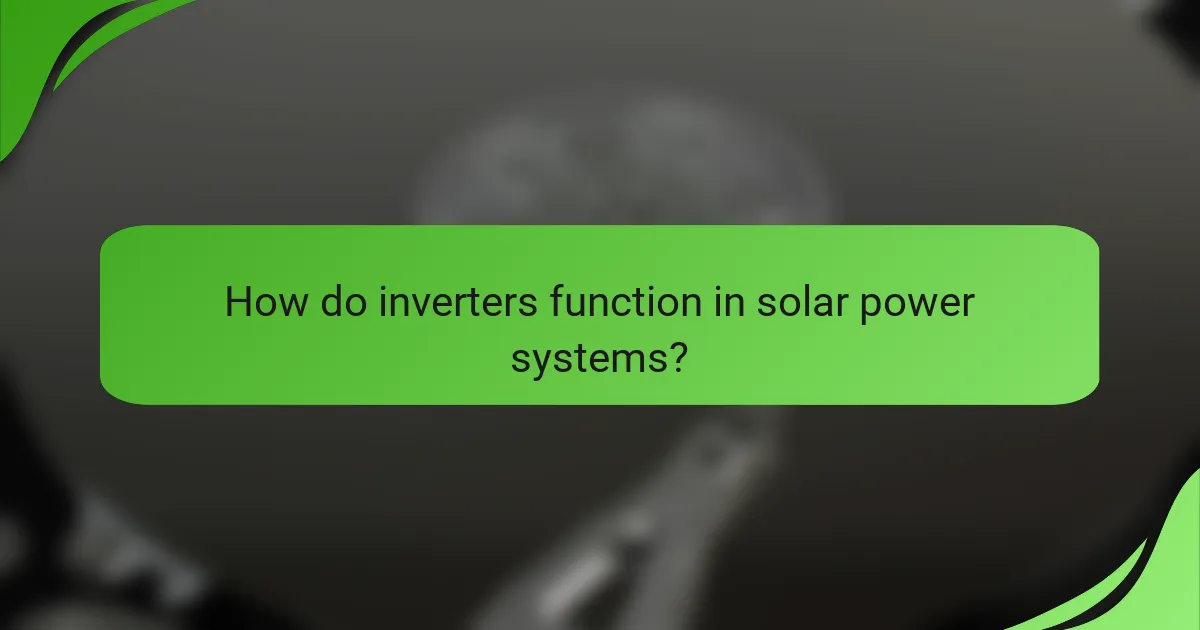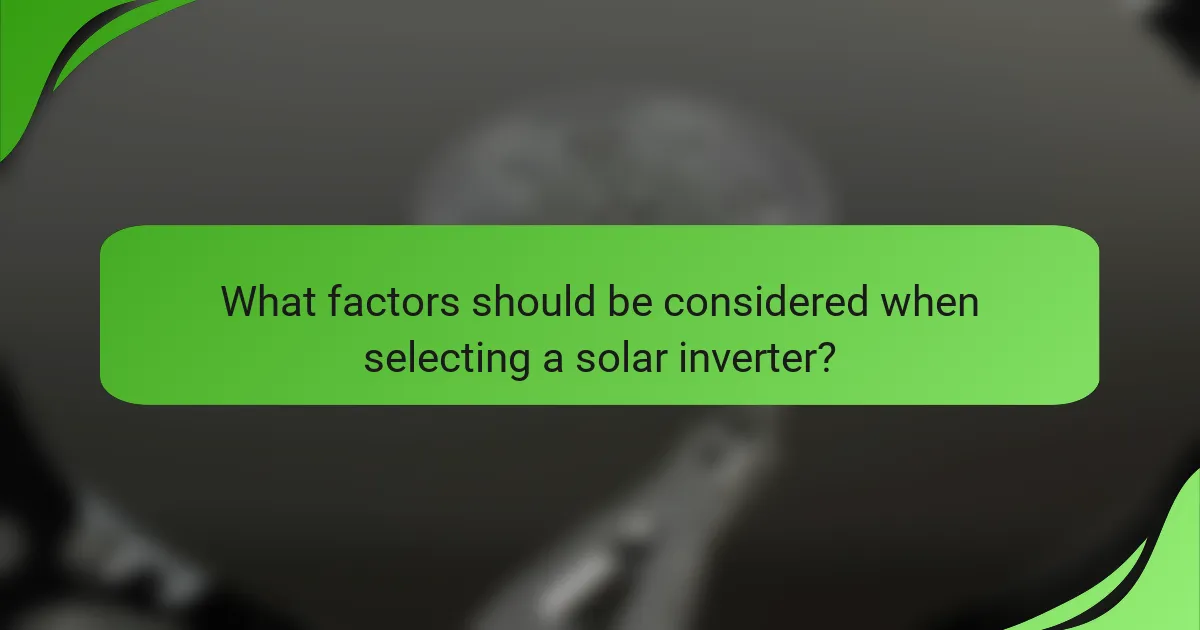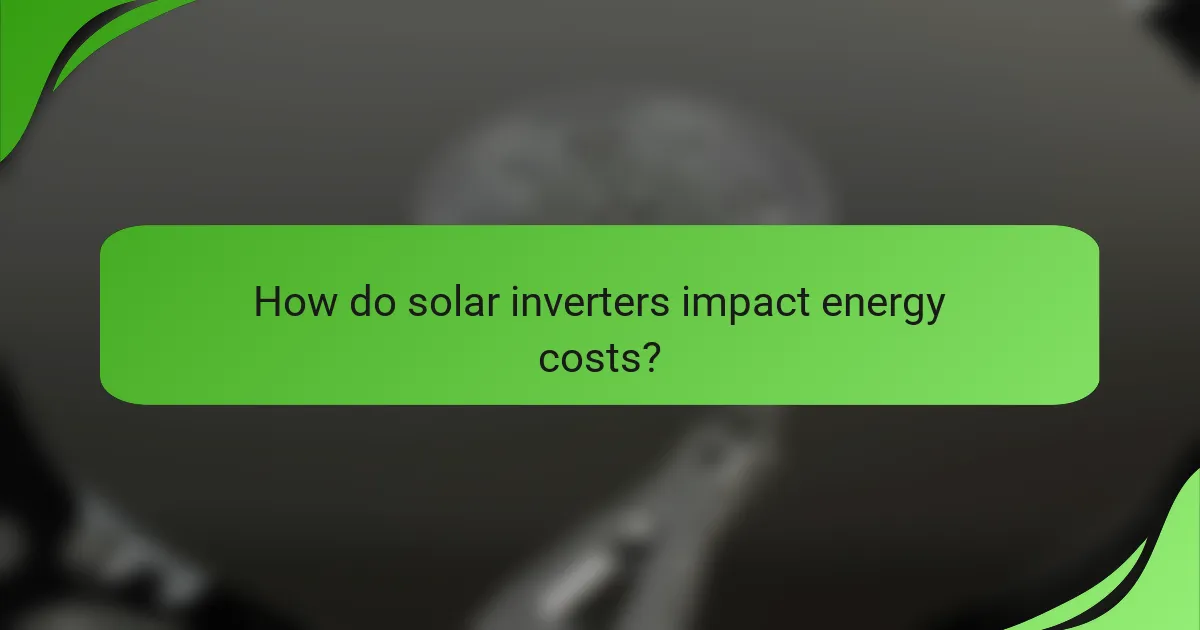Inverters play a vital role in solar power systems by converting the direct current (DC) generated by solar panels into alternating current (AC), which is essential for powering household appliances and connecting to the grid. Various types of inverters, including string inverters, microinverters, and hybrid inverters, each offer unique advantages and functionalities. Their ability to optimize energy production and enhance system efficiency makes them indispensable for maximizing the benefits of solar energy.

What are the types of inverters used in solar power systems?
Solar power systems utilize several types of inverters, each serving distinct functions and offering various advantages. The main types include string inverters, microinverters, power optimizers, hybrid inverters, and battery inverters.
String inverter
String inverters are the most common type used in residential solar installations. They connect multiple solar panels in series, or “strings,” and convert the direct current (DC) generated by the panels into alternating current (AC) for home use.
While string inverters are generally cost-effective and easy to install, their performance can be affected by shading or panel mismatch, as the entire string’s output is limited by the weakest panel. It’s essential to consider the layout of your solar array when choosing this type.
Microinverter
Microinverters are installed on each individual solar panel, allowing for independent operation. This means that if one panel is shaded or underperforming, it does not significantly impact the overall system output.
Microinverters tend to be more expensive than string inverters but can provide higher energy yields, especially in installations with varying shading conditions. They also offer enhanced monitoring capabilities, allowing homeowners to track the performance of each panel.
Power optimizer
Power optimizers are similar to microinverters but work in conjunction with a string inverter. They are installed on each panel and optimize the DC output before sending it to the string inverter for conversion to AC.
This setup combines some benefits of both string inverters and microinverters, improving energy production while maintaining a lower overall cost than a fully microinverter system. Power optimizers are particularly useful in partially shaded environments.
Hybrid inverter
Hybrid inverters can manage both solar energy generation and battery storage, making them ideal for systems that incorporate energy storage solutions. They allow for the simultaneous use of solar power, battery power, and grid power.
These inverters are beneficial for homeowners looking to maximize energy independence and manage energy costs effectively. They can also provide backup power during outages, enhancing the resilience of the solar power system.
Battery inverter
Battery inverters are specifically designed to work with energy storage systems, converting DC power from batteries into AC power for home use. They are essential for off-grid solar systems or homes that want to store excess solar energy for later use.
When selecting a battery inverter, consider compatibility with your battery type and capacity. These inverters can significantly enhance energy management, allowing homeowners to utilize stored energy during peak demand times or outages.

How do inverters function in solar power systems?
Inverters are essential components of solar power systems, converting direct current (DC) generated by solar panels into alternating current (AC) suitable for household use or grid connection. They also optimize energy production and ensure system efficiency.
DC to AC conversion
The primary role of an inverter is to convert the DC electricity produced by solar panels into AC electricity, which is the standard form used by most appliances and the electrical grid. This conversion is crucial because most homes and businesses operate on AC power.
Inverters achieve this through electronic circuitry that switches the DC current on and off rapidly, creating an AC waveform. The quality of this conversion can affect the overall efficiency of the solar power system, so selecting a high-quality inverter is important.
Maximum Power Point Tracking (MPPT)
Maximum Power Point Tracking (MPPT) is a technology used in inverters to maximize the energy harvested from solar panels. It continuously adjusts the electrical operating point of the modules to ensure they operate at their optimal power output.
By using MPPT, inverters can increase energy production by around 10-30% compared to systems without this feature, especially under varying sunlight conditions. This capability is particularly beneficial in regions with fluctuating weather patterns.
Grid synchronization
Grid synchronization is the process by which an inverter aligns the phase and frequency of the electricity it produces with that of the utility grid. This ensures that the power fed back into the grid is compatible and does not disrupt the overall grid stability.
Inverters equipped with grid synchronization capabilities can automatically disconnect during outages to protect utility workers and reconnect when the grid is stable again. Compliance with local regulations, such as those set by the IEEE 1547 standard in the United States, is essential for safe and effective grid interaction.

Why are inverters important in solar power systems?
Inverters are crucial in solar power systems as they convert the direct current (DC) generated by solar panels into alternating current (AC), which is used by most household appliances. They ensure that the energy produced is usable and efficient, making them a key component in maximizing solar energy benefits.
Efficiency enhancement
Inverters enhance the efficiency of solar power systems by optimizing the energy conversion process. High-quality inverters can achieve conversion efficiencies of over 95%, meaning that a minimal amount of energy is lost during the conversion from DC to AC. Selecting an inverter with a high efficiency rating is essential for maximizing energy output.
Additionally, advanced inverters incorporate maximum power point tracking (MPPT) technology, which adjusts the electrical operating point of the modules to ensure they produce the maximum possible power. This can significantly increase overall system performance, especially in varying sunlight conditions.
System reliability
Reliability in solar power systems is heavily dependent on the inverter’s performance. A robust inverter can withstand fluctuations in voltage and current, ensuring consistent energy supply. Regular maintenance and monitoring of the inverter can prevent unexpected failures and prolong the lifespan of the entire system.
Moreover, many modern inverters come equipped with built-in safety features that protect against electrical faults, such as overvoltage or short circuits. These features not only enhance reliability but also ensure compliance with safety regulations, reducing risks associated with solar installations.
Energy management
Inverters play a vital role in energy management within solar power systems, enabling users to monitor and control their energy consumption effectively. Smart inverters can communicate with home energy management systems, allowing users to optimize energy usage based on real-time data and forecasts.
Furthermore, some inverters offer features such as energy storage integration, which allows excess energy generated during peak sunlight hours to be stored for later use. This capability is particularly beneficial for households looking to reduce reliance on the grid and lower electricity bills.

What factors should be considered when selecting a solar inverter?
When selecting a solar inverter, it’s essential to consider factors such as system size, efficiency ratings, and warranty and support. These elements will significantly impact the performance and longevity of your solar power system.
System size
The size of your solar power system directly influences the type of inverter you need. Larger systems may require string inverters or central inverters, while smaller setups can often use microinverters. Ensure that the inverter’s capacity matches or exceeds the total output of your solar panels to optimize performance.
A good rule of thumb is to select an inverter that can handle at least 20% more power than your solar array’s peak output. This buffer helps accommodate fluctuations in energy production and ensures efficiency.
Efficiency ratings
Efficiency ratings indicate how well an inverter converts DC electricity from solar panels into usable AC electricity. Look for inverters with efficiency ratings above 95% to maximize energy output. Higher efficiency means less energy loss during conversion, which translates to more savings on your electricity bill.
Consider the inverter’s performance under varying conditions, such as high temperatures or partial shading. Some inverters perform better than others in these scenarios, so check for performance specifications that reflect real-world conditions.
Warranty and support
A solid warranty and reliable customer support are crucial when choosing a solar inverter. Most reputable manufacturers offer warranties ranging from 5 to 12 years, with some premium options extending up to 25 years. A longer warranty often indicates confidence in the product’s durability.
Additionally, assess the availability of customer support and service options in your area. Quick access to technical assistance can be invaluable if issues arise, ensuring your solar system remains operational and efficient.

How do solar inverters impact energy costs?
Solar inverters play a crucial role in reducing energy costs by converting the direct current (DC) generated by solar panels into alternating current (AC) used in homes and businesses. By optimizing energy conversion and enabling net metering, inverters can significantly lower electricity expenses over time.
Reduction in electricity bills
One of the primary benefits of solar inverters is their ability to reduce electricity bills. By converting solar energy into usable power, homeowners can rely less on grid electricity, leading to substantial savings. In many cases, users can see a reduction of 50% or more in their monthly energy costs.
Additionally, depending on local regulations, excess energy produced can be fed back into the grid, allowing homeowners to earn credits through net metering. This further decreases overall energy expenses, making solar inverters a financially savvy investment.
When considering the installation of solar inverters, it’s essential to evaluate the potential savings against initial costs. Homeowners should seek estimates from reputable solar providers and consider available incentives, which can enhance the financial benefits of solar energy systems.
